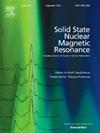在70 kHz的快速MAS下低功率14N去耦
IF 2.4
3区 化学
Q4 CHEMISTRY, PHYSICAL
引用次数: 0
摘要
固体中较高的各向同性分辨率对于精确分配多位点化学和生物系统中的化学位移至关重要;因此,在固体样品中追求类似溶液的分辨率仍然是一个持续的挑战。MAS将各向异性相互作用有效地平均到一阶,而高阶相互作用(如残余偶极分裂(RDS))和各向同性相互作用(如J耦合)仍然存在。随着更快的MAS的出现,RDS和J耦合成为14N键合各向同性1H峰分辨率和灵敏度的重要制约因素。然而,占主导地位的四极耦合阻碍了1H-14N的去耦,因为可实现的14N rf场强度远小于四极耦合的大小。因此,14N编辑光谱通常在没有14N去耦的情况下进行,导致更宽的1H线宽和降低的灵敏度。在此背景下,我们提出了14N-1H自旋对在70 kHz的快速MAS下在1H检测下的连续波(CW) 14N去耦。实验表明,在快速MAS下的非共振低功率14N连续波辐照产生更窄的线宽。利用四极振动框架描述,对最佳解耦效果进行了定性分析。本文章由计算机程序翻译,如有差异,请以英文原文为准。

Low-power 14N decoupling at fast MAS of 70 kHz
Higher isotropic resolution in solids is essential for accurate assignment of the chemical shifts in multisite chemical and biological systems; consequently, the pursuit of solution-like resolution in solid samples remains an ongoing challenge. MAS provides the effective averaging of the anisotropic interactions to the first-order while the higher order interactions, such as residual dipolar splitting (RDS), and isotropic interactions like J coupling remain. With the emergence of faster MAS, RDS and J couplings become significant constraints in the resolution and sensitivity of isotropic 1H peaks bonded to 14N. However, the dominant quadrupolar coupling hampers the decoupling of 1H-14N, since the achievable 14N RF-field strength is much smaller than the size of the quadrupolar coupling. Therefore, 14N edited spectroscopy is typically performed in the absence of 14N decoupling, leading to broader 1H linewidth and reduced sensitivity. In this context, we propose the continuous-wave (CW) 14N decoupling of 14N-1H spin pair under 1H detection at a fast MAS of 70 kHz. We experimentally show that the on-resonance low-power 14N CW irradiation at fast MAS yields the narrower linewidth. Utilizing the quadrupolar jolting frame description, a qualitative analysis of the optimum decoupling effect is provided.
求助全文
通过发布文献求助,成功后即可免费获取论文全文。
去求助
来源期刊
CiteScore
5.30
自引率
9.40%
发文量
42
审稿时长
72 days
期刊介绍:
The journal Solid State Nuclear Magnetic Resonance publishes original manuscripts of high scientific quality dealing with all experimental and theoretical aspects of solid state NMR. This includes advances in instrumentation, development of new experimental techniques and methodology, new theoretical insights, new data processing and simulation methods, and original applications of established or novel methods to scientific problems.

 求助内容:
求助内容: 应助结果提醒方式:
应助结果提醒方式:


